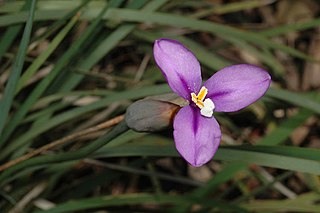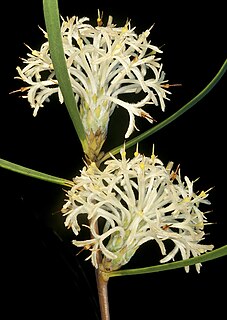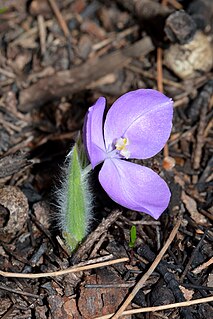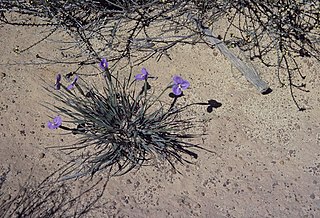
Patersonia, commonly known as native iris or native flag and are native to areas from Malesia to Australia.
Patersonia maxwellii is a species of flowering plant in the iris family Iridaceae and is endemic to the south of Western Australia. It is a tufted, rhizome-forming perennial herb with linear leaves and violet tepals.

Pterostylis barbata, commonly known as the western bearded greenhood or bird orchid is a species of orchid endemic to the south-west of Western Australia. Flowering plants have a rosette of leaves at the base of the plant and a single translucent white flower with dark green veins on a flowering stem with up to 20 stem leaves. It is one of a number of bearded orchids, some of which have yet to be formally described, all of which have a distinctive feather-like labellum.

Leporella fimbriata, commonly known as hare orchid or fringed hare orchid, is the only species in the flowering plant genus Leporella in the orchid family, Orchidaceae and is endemic to the southern Australia mainland. It is related to orchids in the genus Caladenia but has an unusual labellum and does not have hairy leaves. Its pollination mechanism is also unusual.

Patersonia fragilis, commonly known as swamp iris or short purple-flag, is a species of flowering plant in the family Iridaceae family and is endemic to eastern Australia. It is a tufted perennial herb with linear, cylindrical leaves and pale violet to blue-violet flowers.

Patersonia sericea, commonly known as purple flag or silky purple-flag is a species of plant in the iris family Iridaceae and is endemic to eastern Australia. It is a densely-tufted perennial herb with linear, sword-shaped leaves, broadly egg-shaped, bluish-violet tepals and an oval capsule.

Conostylis aurea, commonly known as golden conostylis, is a plant in the bloodwort family Haemodoraceae. It is endemic to the south-west of Western Australia.

Patersonia occidentalis, commonly known as purple flag, or long purple-flag, is a species of flowering plant in the family Iridaceae and is endemic to southern Australia. It is a tufted, rhizome-forming perennial with narrow, sharply-pointed, strap-like leaves, egg-shaped, bluish violet sepals and a cylindrical capsule. The Noongar name for the plant is komma.

Petrophile heterophylla, commonly known as the variable-leaved conebush, is a species of flowering plant in the family Proteaceae and is endemic to southwestern Western Australia. It is a shrub with variably shaped, sometimes pinnately-divided leaves, and oval heads of silky-hairy, yellow to cream-coloured flowers.
Patersonia argyrea is a species of plant in the iris family Iridaceae and is endemic to Western Australia. It is a tufted perennial herb with linear, sword-shaped leaves and violet tepals.

Patersonia babianoides is a species of plant in the iris family Iridaceae and is endemic to the south-west of Western Australia. It is a tufted, rhizome-forming herb with soft, linear to elliptic leaves and blue-violet tepals on a relatively short flowering scape.
Patersonia borneensis is a species of plant in the iris family Iridaceae and is endemic to a restricted area of Borneo. It is a tufted perennial with many leaves and pale lavender to bluish-purple tepals on a flowering stem shorter than the leaves.

Patersonia drummondii, commonly known as Drummond's patersonia, is a species of plant in the iris family Iridaceae and is endemic to the south-west of Western Australia. It is a tufted herb with linear, often twisted leaves and pale violet to purple or blue tepals.

Patersonia glabrata, commonly known as leafy purple-flag, or bugulbi in the Cadigal language, is a species of flowering plant in the family Iridaceae family and is endemic to eastern Australia. It is a perennial herb or subshrub with linear leaves and pale violet flowers.

Patersonia graminea, commonly known as grass-leaved patersonia, is a species of plant in the iris family Iridaceae and is endemic to the south-west of Western Australia. It is a clump-forming herb with linear, grass-like leaves and pale violet tepals.
Patersonia inaequalis, commonly known as unequal bract patersonia, is a species of plant in the iris family Iridaceae and is endemic to a restricted part of the south-west of Western Australia. It is a tufted herb with linear, often twisted leaves and white tepals.
Patersonia juncea, commonly known as rush leaved patersonia, is a species of plant in the iris family Iridaceae and is endemic to a restricted part of the south-west of Western Australia. It is a tufted perennial herb with linear leaves and pale violet tepals.
Patersonia lanata, commonly known as woolly patersonia, is a species of flowering plant in the family Iridaceae family and is endemic to the south of Western Australia. It is a tufted perennial herb with sword-shaped leaves and blue-violet flowers.
Patersonia limbata is a species of plant in the iris family Iridaceae and is endemic to the south of Western Australia. It is a tufted, rhizome-forming herb with sword-shaped, bordered leaves and violet tepals.

Patersonia macrantha is a species of plant in the iris family Iridaceae and is endemic to the northern part of the Northern Territory. It is a tuft-forming herb with linear to sword-shaped leaves and pale violet tepals.











